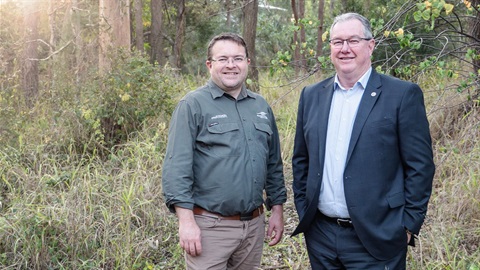Environmental Land Buyback Scheme Hits 100ha Milestone!
Published 28 August 2023

Moreton Bay’s Land Buyback for Environmental Purposes Program has officially ticked over the 100-hectare mark, just three years after its launch.
“We promised our community that we would ‘go green as we grow’ in the face of booming population growth, which is why we’re buying strategic properties to ensure habitat is retained for our local wildlife”, Mayor Flannery said.
“This 5.44ha property in Everton Hills is part of a known fauna movement corridor, so it was the perfect acquisition to enhance the network of properties we’ve already protected from development.
“We will need to rehabilitate a small area and implement weed control over the property to properly restore the area, which is an invaluable investment for our wildlife and biodiversity.
“This program and purchase is a small part of our impressive ambition to protect 75% of Moreton Bay from urban development by retaining our productive rural areas, important greenspace and of course habitat areas for wildlife.
“Our target is to limit Moreton Bay’s urban footprint to just 25% of our total land area, this will make us the green belt between the sprawl of Brisbane and the Sunshine Coast and effectively turn us into the lungs of South East Queensland.
“As Australia’s newest city it’s incumbent on us to start thinking and planning differently, because we don’t want to be like anyone else, we can learn from the mistakes of other cities to set a new standard of what modern sustainability and design looks like.
“My dream is to see our Environmental Land Buyback program expand to the point that it creates green ‘wildlife corridors’ running east-west and north-south, so that wildlife can move around more freely, without encountering the cars and dogs that take their lives.”
Cr Matt Constance (Div 10) said The Hills District is already renowned for its leafy suburban lifestyle, and locals could look forward to seeing more wildlife as Council revegetates the land it buys back.
“This 5.44ha property on Collins Road is situated within the Cabbage Tree Creek ecological corridor and connects Cabbage Tree Creek Reserve with Bunyaville Conservation Park,” Cr Constance said.
“The property creates a continuous network of conservation parks and reserves from Samford Conservation Park, east into Bunyaville Conservation Park”.
“The corridor facilitates movement and dispersal of koalas and other priority species towards core habitat in the Arana Hills, Samford and Bunya areas”.
“Adding further value to this acquisition, the property fronts an existing green infrastructure investment in the form of wildlife crossing and exclusion infrastructure, situated on Collins Road.
“So really, this is a win-win for everyone, since we know locals are most concerned about protecting their environment and lifestyle as our city grows.”